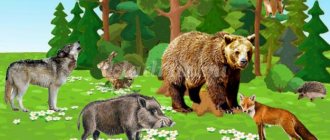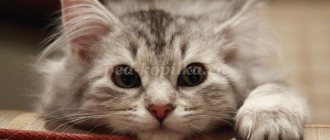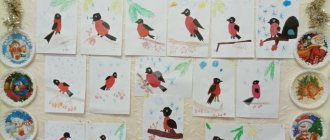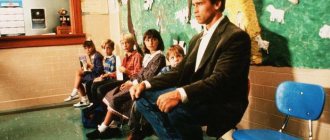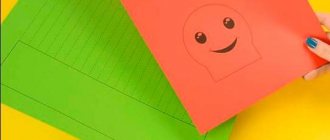Summary of a lesson on cognitive development on the topic: Pets. Junior group
Summary of a lesson on cognitive development in the junior group of the kindergarten “Friendly Hosts”
Author: Kameneva Elena Ivanovna Description of the material: Methodological development is intended for educators working with children of primary and secondary preschool age Purpose: To consolidate ideas about domestic animals. Objectives: Expand and deepen children’s understanding of domestic animals and their cubs;
to fix the external signs of animals, what they eat, how they voice, where they live, what benefits they bring. Develop coherent speech, improve the grammatical structure of speech; consolidate the formation of nouns with diminutive suffixes. Foster love and care for pets. Progress of the lesson
Educator: Do you guys like to visit?
Today we will also go to visit. I suggest you go visit our friends. And so that you find out where we are going to visit, I suggest you guess the riddles. Puzzles. 1. I live under the porch, I have a tail like a ring, I am friends with a person, I look after the house. (Dog.) 2. Who, walking on a leash, nibbles the grass on the hill, And, waiting for the mistress, Lonely bleats: “Me-e-e”? (goat) 3. Who grazes on the lawn, Without a panama hat and without a T-shirt, Drives away harmful flies, And moans protractedly: “Moo-oo” (cow) 4. The nose is a round snout, And the perky tail is a hook. Mom is a pig, dad is a pig. He is their favorite son. (Piglet) 5. I clatter my hooves, I clatter, I gallop, I gallop. The mane curls in the wind. Who is this? (Horse.) 6. Long ear, A ball of fluff. Jumps deftly, gnaws carrots. (Rabbit) 7. With a beard, not a man, With horns, not a bull. (Goat) 8. Shaggy paws, Scratches on paws. (Cat.) Educator: Well done, guys, you completed the task. Can you guess what animals we're talking about? (Children’s answers.) Educator: That’s right about pets, but why are they pets? (Children’s answers.) Educator: Everyone loves affection and animals too, let’s call them affectionately so that they feel pleasant.” Speech game with the ball “Call it kindly.”
Educator: Each of you has a cat at home. She is a very affectionate animal. When you pet her, she loves to purr. And now you and I will turn into cats. Turn around and turn into a cat!” Coordination of speech with the “Cat” movement. You know me closely. I'm a friendly pussy. At the top are the tassels on the ears, the claws are hidden in the pillows. In the dark I see vigilantly, I will not offend in vain. But teasing me is dangerous - I scratch terribly. They walk in a circle on their toes, sneaking, holding their arms bent in front of their chest. They stop, stand facing in a circle, make “ears” from their palms, then “claws” from their fingers. They walk in a circle again, stealthily. They stop again, stand facing in a circle and show their “claws”
Educator: All animals speak their own language. Let's remember who makes what sounds. Game “Who says what?” Who ate my stew? The pig grunts...(oink-oink) How does the pig talk? What is she doing? (“oink” - grunts) Give me some fresh grass! - The goat is bleating... (me-me) How does the goat talk? What is she doing? (“meh” - bleats) They didn’t pour enough milk! The cat meowed... (meow-meow). How does a cat talk? What is she doing? (“meow” - meows) Grab the thief by the sleeve, The dog barked... (woof-woof-woof). How does the dog talk? What is he doing? (“woof-woof” - barks) My master is far away! The horse neighs...(yoke) How does the horse talk? What is she doing? (“E-go-go” - neighs) I don’t understand where the calf is? A cow moos...(moo-oo) How does a cow talk? What is she doing? (“mu” - hums) Educator: Here are the pets on my table. We'll play with them. Game "Who is missing".
Educator: Domestic animals have cubs. Let's play the Baby Pets game and remember them. Game "Baby Pets". The father is a bull, the mother is a cow, the child is a calf. Dad is a goat, mom is a goat, baby is a goat. Dad is a horse, mom is a horse, baby is a foal. Dad is a dog, mom is a dog, baby is a puppy. Father-cat, mother-cat, child-kitten. Dad is a ram, mom is a sheep, baby is a lamb. Dad is a boar, mom is a pig, baby is a pig.
Educator: Now let’s turn around ourselves and turn into rabbits. Physical school Rabbit stretched once, twice, three, four, five times, bent over, twice, bent down, spread his paws to the side, but couldn’t find the carrots. To get the carrots, we need to stand on our tiptoes.
Educator: Guys, animals need to be fed, so let's give them a treat. Game "Feed the Animals". What will you treat the cow? (I will treat the cow with hay.) What will you treat the dog? (I will treat the dog with a bone and meat.) What will you treat the horse with? (I will treat the horse with grass.) What will you treat the cat with (I will treat the cat with fish and milk.) What will you treat the goat with (I will treat the goat with hay.) What will you treat the rabbit with? (I will treat the rabbit with a carrot.) What will you treat the pig? (I will treat the pig with bread) What will you treat the cat? (I'll treat the cat to fish). Educator : And now the most difficult task for you. You need to collect a picture of a pet and name it. Collective task “Cut picture”.
Educator : Well done! Everyone completed the task. Let's think again about what we call pets. We will classify as domestic animals those with whom we live in close contact; Cows and horses, Sheep and goats We shelter them in warmth from the frost. We feed and water them, if they need a haircut, we pet them affectionately, we always take care of them. They are attached to us, very obedient and not indifferent to our voice. Some give us milk and sour cream. Others take us everywhere tirelessly.
We recommend watching:
Summary of GCD in the junior group “How to take care of your teeth?” A lesson on describing toys in the junior group of a kindergarten. Summary of a lesson on cognitive development in a junior group on the topic “Pets and their children. Summary of a lesson on cognitive development in the second junior group using ICT “Travel”
Similar articles:
Synopsis of a physical education lesson in the junior group “Spring Puddles”
Summary of a lesson on speech development and modeling in junior group 1
Summary of educational activities on cognitive and speech development in the 1st junior group
Summary of a lesson on health conservation for the second junior group
Summary of an art lesson in junior group 1
Goal: updating the dictionary on the topic “Pets”.
Tasks:
1. Correctional educational objectives:
- Reinforce ideas about pets.
- Clarify, expand the active vocabulary, enrich the passive vocabulary on the topic “Pets”.
- Develop the grammatical structure of speech (harmonize nouns in the dative case, singular: “Cat and kitten”; nouns in the genitive case singular, the preposition “y” in speech through the exercise “Who has who?”; compose simple and complex sentences, correctly coordinating words)
2. Corrective and developmental tasks:
- Develop dialogical speech.
- Develop auditory attention, thinking, memory, fine motor skills, articulatory motor skills.
3. Correctional and educational tasks:
- Foster friendly relationships between children;
- Develop emotional responsiveness, create a sense of responsibility for pets;
- Give the child the opportunity to choose.
Dictionary:
| Active | Nouns: animal, cow, calf, horse, dog, puppy, cat, kitten, sheep, pig, pig, hay. Verbs: moos, meows, barks, grunts. |
| Passive | Nouns: lamb, foal, oats, acorns, turnips, radishes. Verbs: neighs, bleats. |
Equipment: Tables, chairs, a box, pet figurines, pillows for each child, a pillow for a speech therapist, cardboard horns, walking felt pets, paths, 5 bags of marbles (10-15 pcs.), sound tablets, a glove puppet A dog, pictures of food for animals, paper handkerchiefs (for articulation gymnastics), an audio recording of the voices of pets, curlers, a basket with puppies (5 pieces).
Integration of educational areas: “Speech development”, “Socio-communicative development”, “Cognitive development”.
Types of children's activities: gaming, communicative, motor.
Technologies used in the lesson:
- Health-saving exercises - articulation gymnastics, self-massage, breathing exercises, elements of psycho-gymnastics.
- Information and communication – sound tablets.
- Toy games – storyline of the lesson, glove Dog character, designer walking toys.
- Personality-oriented – creating an atmosphere focused on the child’s individuality, giving the child the right to choose, communication as equals.
Methods and techniques:
- Visual (use of images and figures of animals and their babies)
- Verbal (reading a poem, conversation, dramatization game “Animal Dispute”, exercise “Who has who?”, use of various types of questions (direct, directing, prompting, leading; repetition (by teacher, child, choral); )
- Practical (elements of psycho-gymnastics, showing the position of the articulation organs when performing articulatory gymnastics, didactic game “Help the mother reach her baby”, self-massage)
Progress of the lesson
1. Organizational moment. (Announcement of the topic of the lesson)
Children come in and stand in a circle. The speech therapist suggests greeting each other by performing movements according to the text.
| Let's stand side by side, in a circle, | Children and teacher stand in a circle |
| Let's say “Hello! " each other. | Children and teacher spread their arms to the sides |
| We are not too lazy to say hello: Hi all! " and "Good afternoon! » | Children and teacher shake hands in a circle |
| If everyone smiles - Good morning will begin. | Everyone smiles at each other |
Speech therapist: Good morning, guys, I’m very glad to see you! Sit down on the pillows.
The pillows are arranged in a semicircle, under them are toys of domestic animals (cat, goat, pig, ram, cow, horse). The speech therapist has a figurine of a wild animal under his pillow. If the children do not pay attention to the fact that there is something under the pillow, the speech therapist himself notes that something is in the way, it is uncomfortable for him to sit - everyone takes out their figures.
Speech therapist: Let's put all the figures that we found in the center of the circle (on the lid of the middle box so that everyone can see). Who is this? (animals) Is there an extra animal among them? (bear, removes extra figure) What animals are left? (children's answers). If the children do not name the general word “pets”: These animals live next to humans, which means they…. (domestic). The person takes care of them.
Want to get to know your pets better? Let's hear the cow moo? (dog's voice sounds). The children, with the help of the teacher, note that the cow does not bark, but moos.
The same thing happens when listening to the voices of all animals (they have the place of their voice - the voice of a dog).
Speech therapist: Guys, what do you think happened? (children's answers) Maybe we will find the answer in this box?
He places the box in the center of the circle and opens it. There is a glove toy Dog. The speech therapist puts it on his hand and then conducts a dialogue with the children on behalf of the Dog.
Speech therapist : Oh, that’s who barked!
"Dog": Woof-woof! Hello guys, my name is Druzhok. What happened to you? (children's answers). We need to give the animals their lost voices back . There are tasks hidden in this box, are you ready to complete them? (children's answers).
The speech therapist opens the box, inside of which there are 2 more boxes, and draws the children’s attention to one of the pockets with a picture of a foal.
"Dog": Woof-woof! Who do you think will be helped by the task in this pocket to get their voice back? (horse and foal).
The first task is in one of the pockets of the small (inner) box. The speech therapist takes out a picture of “articulation gymnastics” from his pocket.
Speech therapist: I know what this task is! Would you like me to tell you a story about how Tongue visited the village? And you help me!
Articulatory gymnastics with elements of bioenergoplasty. The dog performs movements in accordance with articulation exercises.
Tongue woke up in the morning, opened the door (open his mouth wide), went outside (stick out his tongue), saw a horse and decided to ride it (exercise “Horse”). In the meadow, he saw a cow chewing grass (imitation of chewing food with a closed mouth). And a goat was grazing nearby. The tongue wanted to come closer, but the goat butted! (the tense tongue makes pushing movements either on the left or on the right cheek). Tongue got scared, jumped on the horse and galloped home (exercise “Horse”). Near the booth, he saw a dog gnawing on a bone (we bite the tongue with our teeth). A pig is slurping at a trough (imitation of chewing food with an open mouth). And the little kitten laps milk from the bowl (we lift the tip of the wide tongue up and move it deep into the mouth). Tongue also decided to have breakfast, went home and closed the door (close his mouth).
If necessary, the speech therapist offers children with increased salivation to wipe their mouths with a paper napkin and puts the napkins in a container.
"Dog": Woof-woof! The first task has been completed, you can remove the picture. Who will the following task help regain their voice? (cow and calf).
The second task is in one of the pockets of the small (inner) box. The dog takes out horn envelopes from the pocket (2 pieces for each child).
Speech therapist: Let's turn into cows and put horns on our index fingers.
The breathing exercise “Cow” (according to B. Tolkachev) is performed while standing.
Let's put our index fingers with “horns” to the head. Let's take a deep breath through the nose, hold our breath a little and as we exhale we continue to say “moooooo...”. We try to keep the sound even. Let's try again (the exercise is repeated 2-3 times).
"Dog": Woof-woof! Has everyone managed to turn into a cow? We have completed this task, let's remove the horns.
Children sit on pillows.
Speech therapist: Have you already guessed who the next task will help regain their voice? (pig and piglet).
The speech therapist takes out a small box from the middle one. The third task is in one of the pockets of the middle box. He takes curlers out of his pocket and distributes one to all the children.
Speech therapist: Let's imagine that this is a washcloth with which the mother pig will rub the back of the piglet. Place the washcloth on your palm and cover it with your other palm.
First, self-massage of one palm is performed, then the second, accompanied by speech.
The mother pig rubs the pig's back in a puddle with a washcloth. The son responded: “Thank you, How nice! Oink oink oink!"
" Dog": Woof-woof! And we completed this task! You can remove our “washcloths”.
And who will be helped by the task in this pocket to regain their voice? (cat and kitten).
The fourth task is in one of the pockets of the middle box. The speech therapist takes felt walking toys (cat, dog, horse, goat, sheep, cow) from the pocket and places them in the center.
Speech therapist: Look how many pets there are in the owner’s yard. And each of them has its own character. Let's stand up and portray an affectionate cat, a sad dog, an angry cow, an offended goat, a cheerful pig.
Children standing perform elements of psycho-gymnastics.
The speech therapist invites the children to choose a toy for themselves and put it on their fingers (shows). The task is performed while lying on your stomach on pillows.
Development of coherent speech, psycho-gymnastics. Composition of the fairy tale “Animal Dispute”.
Speech therapist: One day, pets gathered in the owner’s yard and began to argue which of them was the most necessary for a person.
The dog barked: “ Woof, woof.” I am the most needed because... I know how to bark loudly (addressing a child who has a dog figurine). For example: “I am the most needed because I protect the house.”
The cat meowed affectionately: (offers to answer the child who has a cat figurine). For example: “ Meow-meow, I’m the most needed, because I catch mice.”
Here a kind cow intervened in the dispute. She hummed: (offers to answer the child who has a figurine of a cow). For example: “Moo-oo. I am the most needed because I give milk.”
And the horse neighed angrily: (offers to answer the child who has a horse figurine). For example: “Igo-go. And I drive the owner, help him do all the hard work. I am the most needed pet.”
After listening to the horse, the sheep bleated joyfully: (offers to answer the child who has a sheep figurine). For example: “Bee. It’s me who is the most needed animal, because I provide wonderful warm wool!”
"Dog": Woof-woof! Guys, what do you think is the most necessary animal? (children's answers). If it is difficult for children to answer the question, give a hint that all animals are needed by humans because they all bring benefits.
The walking figurine remains on the child’s hand.
"Dog": Woof-woof! Who will be helped by the task from this pocket to get their voice back? (sheep and lamb).
The fifth task is in one of the pockets of the middle box. The speech therapist takes out marbles from the pocket and invites the children to sit at the tables on which cards with paths are prepared.
"Dog": Woof-woof! Mothers lost their babies. Help build a path from mother to baby. You can make the path whatever you want.
Children use pebbles to make their own path from mother to baby.
Speech therapist: Take a figurine of the animal for which you helped build the path. Walk along the path.
Exercise “Who has who?”
Speech therapist: Did everyone manage to cope with the task? Let's now check who has who? Sasha, who's with the cat? (kitten), etc.
The speech therapist asks the question “A pig, a horse, a cow, ... who?”, the children answer with a complete sentence. After the task is completed, the speech therapist invites the children to put the pebbles into bags, leave the figures, cards and bags on the table, go to the carpet and sit on the pillows.
Speech therapist: Before we find out whether the voices have returned to the pets, there is one more task to complete. Take the animal figurines we found under the pillow
The speech therapist places a container with animals in the center, and the children choose one figurine. Then the speech therapist takes 5 sound tablets from the bag. Each of them has a picture of food that some pet is eating. The tablets are laid out in the center (in a circle, facing the children).
Speech therapist: What can you treat the pet you have chosen? Choose a tablet with a suitable picture and place it next to you (children complete the task). What will you treat the cat, Sasha? (milk).
The speech therapist asks a similar question to each child.
"Dog": Woof-woof! Guys, you completed all the tasks! Want to see if the animals' voices have returned? Just let's do it one at a time! Sasha, pick up the picture and press the button that is hidden under the picture.
Children take turns doing the task. Animal voices pre-recorded on sound pads sound correct.
Speech therapist: (after the child pressed the button and everyone heard the animal’s voice). For example: Has the cat's voice returned? How does she voice? (meows) How does a dog sound? (barks) How a cow sounds (moos), etc.
"Dog": Woof-woof! Thank you guys for giving back the voices to my pet friends.
After the task is completed, the speech therapist invites the children to put the tablets and animals in the box.
Evaluation of performance results (Reflection).
Speech therapist : Which task was the most difficult? If you liked the activity, you can clap your hands loudly, but if not, there is no need to clap. Did you like the lesson?
“Dog”: Oh, guys, don’t you hear anything? (pretends to listen). I think the sounds are coming from here!
A speech therapist with a “dog” on his arm approaches the basket, quietly turns on the speaker: puppies squeak.
Speech therapist: Who's here? (raises the blanket, under it are 5 puppies made from gloves using the same technique as the Dog).
“Dog”: These are my puppies! They were so interested that the entire lesson they sat quietly in the basket and listened. They liked you so much that they wanted to be friends with you! Do you want to make friends with them? Well, choose your friend!
Children choose puppies and put them on their hands.
Speech therapist: Everyone has their own friend. Sasha, what will you do with him? (play, walk, study, have fun....)
Asks each child what he will do with his puppy friend.
“Dog”: Don’t offend your new friends! Take care of them, play with them. Let me take you to the group!

